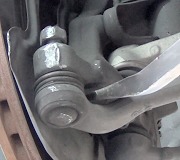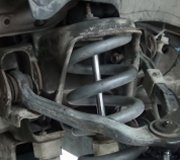Sorry to leave you hanging for so long. Just got back home.
Is getting the ball joint stud to reach the spindle the problem or the stud is too fat to go into the hole? How was the truck lifted?
Altering the ride height from factory specifications is a real bad idea in my book because I'm a suspension and alignment specialist and a brake specialist, and I understand how both systems are seriously degraded. There are some kits out there that lower the axle on the spindle. Those do not change the geometry of the control arms. If I am forced to work on a truck that's been lifted, that's how I'd prefer it to be done.
I've owned a lot of Chrysler muscle cars from the '70s that all used torsion bars. Those were real easy to adjust to make them look cool, but now that I'm smarter, I keep all of my cars exactly at the specified height. Since you mentioned torsion bars I'm assuming that's what you have. If you don't see or recognize any aftermarket or altered suspension parts on the front, it is likely the torsion bars were just cranked up. Normally you need to support the lower control arm so it and the spindle move as high as possible, then you usually need a long pry bar to pull the upper control arm down as you guide the stud into the hole. If the torsion bars are cranked up too much, the truck is just going to raise off the jack stand when you use a floor jack to raise the lower control arm. It would have popped apart with a lot of force too when you took the old ball joint apart.
Naturally I'd like to see you put the ride height back where it's supposed to be, but if you aren't ready to fix whatever was done in the rear, count the number of revolutions it takes on the adjuster bolts as you turn them counter-clockwise. Those bolts are good for at least ten revolutions. That will reduce the stress on the torsion bars and allow you to jack the lower control arms up easier. Once the ball joints are bolted together, turn the torsion bars back up the same number of turns. After you drive the truck and bounce it a little, measure from the ground to two identical spots, one on each side, to see if it's sitting level side-to-side.
If your upper ball joints are the common GM design with a wing with four bolt holes, the truck must be aligned when you're done. If you have a pressed-in round ball joint, you won't change the alignment just from replacing the joint, however, when ride height is changed it will greatly change the alignment. If you look at the two control arms from the front, you'll see that when it's at the proper height, the lower arm will be perfectly parallel to the ground, and the upper one will be angled down toward the upper ball joint. That is the geometry that provides the best tire wear. If the truck was raised by cranking up the torsion bars the upper control arm will be angled down much more. That will make the top of the tire move in and out a real lot as the truck's suspension moves up and down while driving. That's a small part of what degrades the handling, braking, and tire wear.
Friday, September 13th, 2013 AT 12:27 AM



